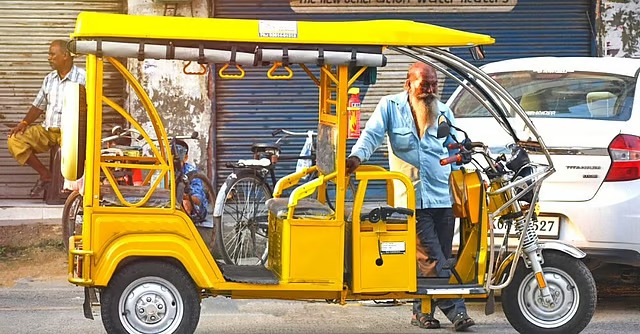L.N. Mittal, J.@mdashPlaintiffs Mange and his son Jai Kishan who were successful in the trial court but have been non-suited by the lower appellate court are in second appeal.
2. Plaintiffs-appellants filed suit alleging that plaintiff No. 1 is owner of 14 kanals 14 marlas land being l/6th share of 88 kanals 4 marlas and plaintiff No. 2 is owner of 4 kanals 5 marlas land out of the aforesaid joint land. It was pleaded that as per jamabandi for 1967-68, plaintiff No. 1 is owner of 14 kanals 14 marlas land and Dei Chand and Desh Raj also had share of 14 kanals 14 marlas each in the aforesaid land whereas Shoe Nath had 44 kanals 2 marlas land being half share of the aforesaid joint land. Inheritance mutation nos. 1166, 1167 and 1178 regarding shares of Dei Chand, Desh Raj and Shoe Nath were sanctioned. After preparation of subsequent jamabandies mutation No. 1179 was sanctioned wherein error regarding shares of different co-sharers was committed. Share of Amar Singh (father of Ramesh defendant No. 10) and of Hari Chand was wrongly depicted as 2/3rd instead of 3/5th share. Plaintiff No. 2 also purchased 4 kanals 5 marlas land from Amar Singh aforesaid. Thus, total share of plaintiffs comes to 18 kanals 19 marlas but in the revenue record they have been depicted to be owners of 16 kanals 8 marlas. Accordingly, the plaintiffs sought declaration that they are owners in possession of 18 kanals 19 marlas land. They also sought direction to defendants No. 11 and 12, State of Haryana and Patwari to correct the revenue entries.
3. Defendants No. 1 and 4 filed written statement which was also adopted by defendants No. 2 and 3. They pleaded that they did not get any excess share.
4. Defendants No. 9 and 10 also contested the suit and broadly controverted the plaint averments. It was pleaded that the mutation in revenue entries cannot be challenged at this stage. It was also pleaded that the revenue entries are correct and shares of different co-sharers have been correctly depicted therein. It was also pleaded that the suit is barred by res judicata and Order 2 Rule 2 of the CPC (in short, CPC). Suit was also pleaded to be barred by limitation. Various other pleas, were also raised.
5. Defendants No. 11 and 12 also contested the suit and tried to justify the revenue entries.
6. Learned Additional Civil Judge (Senior Division), Gohana vide judgment and decree dated 28.11.2008 decreed the plaintiffs'' suit. However, first appeal preferred by defendant No. 10-Ramesh has been allowed by learned Additional District Judge, Sonepat vide judgment and decree dated 10.4.2009 and thereby suit filed by the plaintiffs has been dismissed. Feeling aggrieved, plaintiffs have filed the instant second appeal.
7. I have heard learned counsel for the parties and perused the case file.
8. From the documentary evidence on record, it has been proved that plaintiff No. 1 has share of 14 kanals 14 marlas in the joint land in question as is also evident from the jamabandi for 1967-68. It is also evident from mutation 1953 Ex. P15 that Jai Kishan plaintiff No. 2 purchased 4 kanals 5 marlas land from -Amar Singh father and predecessor of defendant No. 10-Ramesh. Consequently, plaintiffs are proved to be owners of the suit land to the extent claimed by them.
9. On 5.10.2010, counsel for respondent No. 1 (defendant No. 10), inter alia, contended that according to plaint averments, Amar Singh transferred land in excess of his share and, therefore, last transferee of Amar Singh has to suffer. On 6.4.2011, counsel for appellant responded to the said contention by submitting that vide mutation No. 2024 Ex. PI6, Ramcsh defendant No. 10/respondent No. 1 himself got land from his father Amar Singh by way of release deed dated 21.12.2005 and therefore, he is last transferee. Learned counsel for respondent No. 1, however, contended that other transferees of Amar Singh have not been made party to the suit to determine as to who has to suffer on account of transfer of land in excess of his share by Amar Singh.
10. I have carefully considered the aforesaid contentions. In so far as share of plaintiff No. 1 is concerned, he is original co-sharer in the land as depicted in the jamabandi for 1967-68. As regards share purchased by plaintiff No. 2 from Amar Singh it has not been depicted that the said sale by Amar Singh to plaintiff No. 2 was in excess of share of Amar Singh. On the contrary, even thereafter Amar Singh made various transfers including transfer to defendant No. 10 himself. It may, however, be clarified that judgment in the instant list shall have no bearing on the rights of the persons who are not party to the instant list. However, plaintiffs cannot be non-suited merely because some other alleged transferees of Amar Singh have not been made party to the suit. On the contrary, learned counsel for the appellants submits that the said transferees are also party to the suit.
11. Learned counsel for respondent No. 1 contended that in view of Section 158(2Xvi) of the Punjab Land Revenue Act, 1887 (in short, the Act) civil court has no jurisdiction to order correction of revenue entries and therefore, civil court had no jurisdiction to adjudicate the instant suit. The contention merits part acceptance. Jurisdiction of civil court to order correction of revenue entries is barred by the aforesaid statutory provision. However, jurisdiction of civil court to entertain the entire suit is not barred. On the contrary, Section 45 of the Act specifically confers jurisdiction on civil court to grant declaration of rights of the parties who may be aggrieved by an entry made in the record of rights. Section 45 of the Act is reproduced hereinunden-
45. Suit for declaratory decree by persons, aggrieved by an entry in a record: - If any person considers himself aggrieved, as to any right of which he is in the possession by an entry in a record-of-rights or in an annual record, he may institute a suit for a declaration of his right under Chapter VI of the Specific Relief Act, 1877.
12. In the instant case, plaintiffs felt aggrieved by entries in the revenue record i.e. record of rights and therefore, u/s 45 of the Act, the plaintiffs are entitled to institute civil suit in civil court for declaration of their rights. Consequently, civil court has jurisdiction to adjudicate upon the suit regarding declaration of rights of the plaintiffs in the suit land although civil court has no jurisdiction to direct revenue authorities to make correction in the revenue entries.
13. Learned counsel for respondent No. 1 also contended that plaintiff No. 2 was not aggrieved by the wrong revenue entries which existed prior to purchase of land by him from Amar Singh because on the basis of pre-existing entries, plaintiff No. 2 purchased land from Amar Singh. The contention is misconceived and untenable. Plaintiff No. 2 purchased land from Amar Singh within the share of Amar Singh. However, if the ''share of plaintiffs is depicted to be lesser than the share of their actual ownership, it cannot be said that the plaintiffs have no remedy. Plaintiffs have remedy to seek declaration of their rights in view of section 45 of the Act as well as in view of Section 9 CPC.
14. Counsel for respondent No. 1 also contended that suit is barred by res judicata as well as by Order 2 Rule 2 CPC because plaintiff No. 1 had previously instituted suit vide plaint Ex. DW2/A which was dismissed vide, order dated 14.8.2002 Ex. DW2/B. The contention is completely misconceived and meritless. Perusal of order dated 14.8.2002 reveals that the said suit was dismissed for non-prosecution under Order 9 Rule 2 CPC because process fee and correct addresses were not filed by plaintiff No. 1 (sole plaintiff in that suit) in spite of repeated opportunities. It is, thus, apparent that the said suit was not adjudicated on merits and therefore, question of the instant suit being barred by res-judicata would not arise. On the contrary the said previous suit was dismissed under Order 9 Rule 2 CPC and consequently in view of specific provision of Order 9 Rule 4 CPC fresh suit is competent. Order 9 Rule 4 CPC provides that where a suit is dismissed under Order 9 Rule 2 CPC, the plaintiff may bring a fresh suit. Thus, the instant suit is maintainable in view of specific provision of Order 9 Rule 4 CPC and it is not barred under Order 2 Rule 2 CPC or by res judicata. Learned counsel for respondent No. 1 cited judgment of Hon''ble Supreme Court in
15. Learned counsel for respondent No. 1 also contended that suit is barred by limitation as the wrong revenue entries came to the knowledge of the plaintiff at least when mutation Ex. PI5 was sanctioned in favour of plaintiff No. 2 and therefore, the suit is barred by limitation. The contention cannot be accepted. The said mutation was sanctioned on 5.7.2004 and therefore, the suit is not barred by limitation. Learned counsel for respondent No. 1 referred to date of sale deed in favour of plaintiff No. 2 i.e. 6.7.1999 and contended that suit is barred by limitation computed from the said date. The contention cannot be accepted. The plaintiffs are owners in possession of the land to the extent of their share. Consequently, mere wrong revenue entries would not be sufficient to bar the suit by limitation.
16.For the reasons aforesaid, it is apparent that findings of the lower appellate court non-suiting the plaintiffs are perverse and illegal. Substantial question of law to this effect arises for adjudication in the instant second appeal and the same is answered in favour of the plaintiffs for the reasons recorded hereinbefore.
17. As a necessary corollary of the discussion aforesaid, the instant second appeal is allowed. Judgment and decree of the lower appellate court are set aside. Judgment and decree of the trial court are modified. Plaintiffs'' suit is decreed declaring that they are owners in possession of 18 kanals 19 marlas land out of 88 kanals 4 marlas land i.e. plaintiff No. 1 is owner in possession of 14 kanals 14 marlas and plaintiff No. 2 is owner in possession of 4 kanals 5 marlas land. However, relief regarding mandatory injunction directing defendants No. 11 and 12 to correct the revenue entries is declined as jurisdiction of civil court to give any such direction is barred under section. 158(2Xvi) of the Act.

